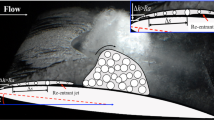Abstract
The aim of this study is to investigate experimentally the effect of surface roughness on cloud cavitation around Clark-Y hydrofoils. High-speed video and particle image velocimetry (PIV) were used to obtain cavitation patterns images (Prog. Aerosp. Sci. 37: 551–581, 2001), as well as velocity and vorticity fields. Results are presented for cloud cavitating conditions around a Clark-Y hydrofoil fixed at angle of attack of \(\alpha =8{^{\circ }}\) for moderate Reynolds number of \(Re=5.6 \times 10^{5}\). The results show that roughness had a great influence on the pattern, velocity and vorticity distribution of cloud cavitation. For cavitating flow around a smooth hydrofoil (A) and a rough hydrofoil (B), cloud cavitation occurred in the form of finger-like cavities and attached subulate cavities, respectively. The period of cloud cavitation around hydrofoil A was shorter than for hydrofoil B. Surface roughness had a great influence on the process of cloud cavitation. The development of cloud cavitation around hydrofoil A consisted of two stages: (1) Attached cavities developed along the surface to the trailing edge; (2) A reentrant jet developed, resulting in shedding and collapse of cluster bubbles or vortex structure. Meanwhile, its development for hydrofoil B included three stages: (1) Attached cavities developed along the surface to the trailing edge, with accumulation and rotation of bubbles at the trailing edge of the hydrofoil affecting the flow field; (2) Development of a reentrant jet resulted in the first shedding of cavities. Interaction and movement of flows from the pressure side and suction side brought liquid water from the pressure side to the suction side of the hydrofoil, finally forming a reentrant jet. The jet kept moving along the surface to the leading edge of the hydrofoil, resulting in large-scale shedding of cloud bubbles. Several vortices appeared and dissipated during the process; (3) Cavities grew and shed again.






Similar content being viewed by others
References
Wang, G.Y., Senocak, I., Shyy, W., et al.: Dynamics of attached turbulent cavitating flows. Prog. Aerosp. Sci. 37, 551–581 (2001)
Kawanami, Y., Kato, H., Yamaguchi, H., et al.: Mechanism and control of cloud cavitation. J. Fluids Eng. 119, 788–794 (1997)
Sato, K., Shimojo, S.: Detailed observations on a starting mechanism for shedding of cavitation cloud. In: The 5th International Symposium on Cavitation, Japan, November (2015)
Wang, Z.Y., Huang, B., Wang, G.Y., et al.: Experimental and numerical investigation of ventilated cavitating flow with special emphasis on gas leakage behavior and re-entrant jet dynamics. Ocean Eng. 108, 191–201 (2015)
Huang, X., Zhang, M.D., Fu, X.N.: Experimental study of coatings’ effect on cavitating flow. J. Ship Mech. 19, 35–42 (2015)
Arndt, R.E., Ippen, A.T.: Rough surface effects on cavitation inception. J. Fluids Eng. 90, 249–261 (1968)
Rood, E.P.: Review–mechanisms of cavitation inception. J. Fluids Eng. 113, 85680U–85680U-7 (1991)
Chang, J.C., Huang, S.B., Lin, C.B.: Effects of inlet surface roughness, texture, and nozzle material on cavitation. Atom. Sprays. 16, 299–318 (2006)
Shimizu, S., Ihara, A., Okada, M.O., et al.: Damage due to spot cavitation on hemispherical cylindrical body. Nippon Kikai Gakkai Ronbunshu B Hen/Transactions of the Japan Society of Mechanical Engineers Part B. 68, 1691–1696 (2002)
Fathollah, V., Dorothee, D., Dierk, R.: Roughness-induced flow instability: a lattice Boltzmann study. J. Fluid Mech. 573, 191–209 (2007)
Stutz, B., Reboud, J.L.: Two-phase flow structure of sheet cavitation. Phys. Fluids. 9, 3678–3686 (1997)
Stutz, B.: Influence of roughness on the two-phase flow structure of sheet cavitation. J. Fluids Eng. 125, 652–659 (2003)
Huang, B., Yin, L.Y., Wang, G., et al.: Combined experimental and computational investigation of unsteady structure of sheet/cloud cavitation. J. Fluids Eng. 135, 071301 (2013)
Williams, M., Kawakami, E., Amromin, E., et al. : Effects of surface characteristics on hydrofoil cavitation. In: Proceedings of the 7th International Symposium on Cavitation, Michigan, August (2009)
Zhang, M., Song, X., Wang, G.: Design and application of cavitation flow image programs. Trans. Beijing Inst. Technol. 26, 17 (2006)
Acknowledgements
The project was supported from the National Natural Science Foundation of China (Grant 51106009) and the China Scholarship Council (Grant 2011307311).
Author information
Authors and Affiliations
Corresponding author
Rights and permissions
About this article
Cite this article
Hao, J., Zhang, M. & Huang, X. The influence of surface roughness on cloud cavitation flow around hydrofoils. Acta Mech. Sin. 34, 10–21 (2018). https://doi.org/10.1007/s10409-017-0689-0
Received:
Revised:
Accepted:
Published:
Issue Date:
DOI: https://doi.org/10.1007/s10409-017-0689-0



